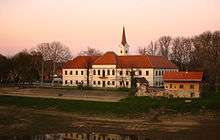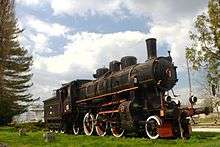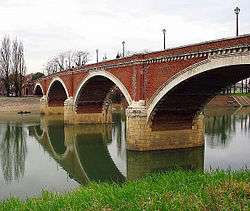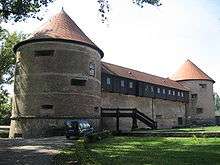Sisak
| Sisak Sisak | |||||||
|---|---|---|---|---|---|---|---|
| City | |||||||
Top: Old bridge over the Kupa river; Center left: Antun Gustav Matoš monument; Center right: Sisak Fortress; Bottom left: Holland Storehouse; Bottom right: Roman ruins of Siscia | |||||||
| |||||||
 Sisak Location of Sisak within Croatia | |||||||
| Coordinates: 45°29′N 16°22′E / 45.483°N 16.367°E | |||||||
| Country |
| ||||||
| County |
| ||||||
| Government | |||||||
| • Mayor | Kristina Ikić Baniček[1] (SDP) | ||||||
| Area | |||||||
| • City | 422.75 km2 (163.22 sq mi) | ||||||
| • Metro | 989.50 km2 (382.05 sq mi) | ||||||
| Elevation | 98 m (321.52 ft) | ||||||
| Population (2011)[2] | |||||||
| • City | 47,768 | ||||||
| Time zone | CET (UTC+1) | ||||||
| • Summer (DST) | CEST (UTC+2) | ||||||
| Postal code | 44000 | ||||||
| Area code(s) | 044 | ||||||
| Patron saints | Quirinus of Sescia | ||||||
| Website |
www | ||||||
Sisak (Croatian pronunciation: [sǐːsak]; also known by other alternative names) is a city in central Croatia located at the confluence of the Kupa, Sava, and Odra rivers, 57 km (35 mi) southeast of the Croatian capital Zagreb. The city's total population in 2011 was 47,768 of which 33,322 live in the urban settlement (naselje).[3]
Sisak is the administrative centre of the Sisak-Moslavina County, Croatia's biggest river port and a centre of river shipping industry (Dunavski Lloyd). It lies on the main road Zagreb-Sisak-Petrinja (M12.2) and the railroad Zagreb-Sisak-Sunja. Sisak is a regional economic, cultural and historical center. The largest oil refinery in Croatia is located here.[4]
Name
Prior to the invasion by the Roman Empire, the region was Celtic and Illyrian and the city there was named Segestica.[5]
In German the town is known as Sissek, in Hungarian as Sziszek, Latin as Siscia and in Kajkavian and Slovene as Sisek.
Geography
Sisak is situated at the confluence of three rivers, the Sava, the Kupa and the Odra, and is usually considered to be where the Posavina (Sava basin) begins, with an elevation of 99 m.
Climate
| Climate data for Sisak (1971–2000, extremes 1949–2014) | |||||||||||||
|---|---|---|---|---|---|---|---|---|---|---|---|---|---|
| Month | Jan | Feb | Mar | Apr | May | Jun | Jul | Aug | Sep | Oct | Nov | Dec | Year |
| Record high °C (°F) | 21.4 (70.5) |
23.4 (74.1) |
27.4 (81.3) |
31.1 (88) |
34.3 (93.7) |
38.1 (100.6) |
42.8 (109) |
46.4 (115.5) |
34.9 (94.8) |
29.6 (85.3) |
25.0 (77) |
23.7 (74.7) |
46.4 (115.5) |
| Average high °C (°F) | 3.7 (38.7) |
6.8 (44.2) |
12.2 (54) |
16.7 (62.1) |
21.9 (71.4) |
24.8 (76.6) |
27.0 (80.6) |
26.6 (79.9) |
22.4 (72.3) |
16.2 (61.2) |
9.1 (48.4) |
4.7 (40.5) |
16.0 (60.8) |
| Daily mean °C (°F) | 0.5 (32.9) |
2.4 (36.3) |
6.8 (44.2) |
11.2 (52.2) |
16.2 (61.2) |
19.4 (66.9) |
21.2 (70.2) |
20.4 (68.7) |
16.1 (61) |
10.8 (51.4) |
5.3 (41.5) |
1.5 (34.7) |
11.0 (51.8) |
| Average low °C (°F) | −3.1 (26.4) |
−2.0 (28.4) |
1.5 (34.7) |
5.4 (41.7) |
9.9 (49.8) |
13.1 (55.6) |
14.7 (58.5) |
14.3 (57.7) |
10.5 (50.9) |
6.1 (43) |
1.6 (34.9) |
−1.7 (28.9) |
5.9 (42.6) |
| Record low °C (°F) | −40.2 (−40.4) |
−28 (−18) |
−18.4 (−1.1) |
−17 (1) |
−8.3 (17.1) |
−6.9 (19.6) |
−4.4 (24.1) |
3.9 (39) |
−1.8 (28.8) |
−7.2 (19) |
−15.6 (3.9) |
−19.2 (−2.6) |
−40.2 (−40.4) |
| Average precipitation mm (inches) | 49.0 (1.929) |
48.2 (1.898) |
55.0 (2.165) |
69.4 (2.732) |
79.4 (3.126) |
94.7 (3.728) |
80.2 (3.157) |
77.8 (3.063) |
84.5 (3.327) |
78.7 (3.098) |
91.1 (3.587) |
68.3 (2.689) |
876.1 (34.492) |
| Average precipitation days (≥ 0.1 mm) | 11.7 | 10.9 | 11.6 | 13.8 | 13.0 | 13.8 | 10.9 | 10.1 | 11.5 | 12.3 | 12.0 | 12.4 | 143.9 |
| Average snowy days (≥ 1.0 cm) | 11.8 | 8.4 | 2.5 | 0.4 | 0.0 | 0.0 | 0.0 | 0.0 | 0.0 | 0.0 | 3.5 | 8.3 | 34.8 |
| Average relative humidity (%) | 85.0 | 78.7 | 71.3 | 68.5 | 69.8 | 71.1 | 71.1 | 74.9 | 79.9 | 82.8 | 85.8 | 87.3 | 77.2 |
| Mean monthly sunshine hours | 52.7 | 93.2 | 142.6 | 174.0 | 235.6 | 246.0 | 285.2 | 257.3 | 186.0 | 114.7 | 54.0 | 43.4 | 1,884.7 |
| Source: Croatian Meteorological and Hydrological Service[6][7] | |||||||||||||
History



Roman period
During the Roman Empire when Sisak was known as Siscia, a Roman mint in the city produced coins under a series of emperors between 262 and 383 AD.[8] It was in this period that the Christian martyr Quirinus of Sescia was tortured and nearly killed during Diocletian's persecution of Christians. Legend has it that they tied him to a millstone and threw him into a river, but he freed himself from the weight, escaped and continued to preach his faith. Today he is the patron saint of Sisak.
Middle Ages
Braslav of Lower Pannonia reigned from Sisak until he was killed in the Hungarian invasion ca. 898.[9] According to Historia Salonitana, Duke Tomislav reclaimed it soon after.[10][11]
Early modern
The 16th-century triangular fortress of the Old Town, well-preserved and turned into the Native Museum, is the main destination of every tourist. The fortress is famous for the victory of the joint forces of Croats, Austrians and Carniolans (Slovenes) over the Ottomans in 1593, known as the Battle of Sisak. It was one of the early significant defeats of the up-to-then invincible Ottoman army on European territory. The Croatian Ban Thomas Erdődy who led the defense in this battle became famous throughout Europe. The Baroque palace of Mali Kaptol, the classicist Veliki Kaptol, the brick Stari most ("Old Bridge") over the Kupa, and the ethnological park are the most frequently visited landmarks.
Modern
In the late 19th and early 20th century, Sisak was a district capital in the Zagreb County of the Kingdom of Croatia-Slavonia.
Contemporary
From 1929-39, Sisak was part of the Sava Banovina and from 1939-41 of the Banovina of Croatia within the Kingdom of Yugoslavia. During World War II, Sisak children's concentration camp was set up by the Croatian Axis Ustaše government for Serbian, Jewish and Romani children. It is estimated that 1,152–2,000 children were killed in the camp.[12]
With the outbreak of the Croatian War in 1991, Sisak remained in Croatian hands while the territory to the south was controlled by Serbs. In 1991-92, the Croatian Army killed 611 civilians in Sisak, of whom 595 were Serbs, 14 Croats and 2 Bosniaks, according to Domagoj Margetić sr.[13][14]
During the war, the Serb forces often shelled the city, causing dozens of civilian casualties and extensive damage to the city's industry.[15] The war ended with the Operation Storm (1995), which led to 150,000–200,000 ethnic Serbs fleeing Croatia; the number of Serbs in Sisak decreased from 12,017 (1991) to 3,897 (2001).
Demographics
| Historical population of Sisak | ||
|---|---|---|
| Year | Pop. | ±% |
| 1857 | 15,738 | — |
| 1869 | 18,669 | +18.6% |
| 1880 | 20,433 | +9.4% |
| 1890 | 22,829 | +11.7% |
| 1900 | 24,277 | +6.3% |
| 1910 | 26,014 | +7.2% |
| 1921 | 26,234 | +0.8% |
| 1931 | 28,799 | +9.8% |
| 1948 | 28,893 | +0.3% |
| 1953 | 30,921 | +7.0% |
| 1961 | 32,821 | +6.1% |
| 1971 | 37,633 | +14.7% |
| 1981 | 42,822 | +13.8% |
| 1991 | 45,531 | +6.3% |
| 2001 | 47,212 | +3.7% |
| 2011 | 47,768 | +1.2% |
| Source: Naselja i stanovništvo Republike Hrvatske 1857–2001, DZS, Zagreb, 2005 & Popis stanovništva 2011 | ||
The city administrative area is composed of the following settlements:[2]
- Blinjski Kut, population 278
- Budaševo, population 1,660
- Bukovsko, population 89
- Crnac, population 553
- Čigoč, population 97
- Donje Komarevo, population 322
- Gornje Komarevo, population 508
- Greda, population 861
- Gušće, population 387
- Hrastelnica, population 898
- Jazvenik, population 142
- Klobučak, population 68
- Kratečko, population 200
- Letovanci, population 52
- Lonja, population 111
- Lukavec Posavski, population 127
- Madžari, population 235
- Mužilovčica, population 74
- Novo Pračno, population 444
- Novo Selo, population 624
- Novo Selo Palanječko, population 517
- Odra Sisačka, population 814
- Palanjek, population 318
- Prelošćica, population 528
- Sela, population 969
- Sisak, population 33,049
- Stara Drenčina, population 223
- Staro Pračno, population 896
- Staro Selo, population 110
- Stupno, population 480
- Suvoj, population 42
- Topolovac, population 894
- Veliko Svinjičko, population 271
- Vurot, population 102
- Žabno, population 509
In the 2011 census, of the total population of 47,768 there were 40,590 Croats (84.97%), 3,071 Serbs (6.43%), 1,646 Bosniaks (3.45%), 648 Romani (1.36%), 179 Albanians (0.37%), 29 Montenegrins (0.06%), and the rest were other ethnicities. In the 2011 census, the population by religion was 37,319 Roman Catholics (78.13%), 3,279 Orthodox Christians (6.86%), 2,442 Muslims (5.11%), and others.
Education
The city hosts University of Zagreb's Faculty of Metallurgy.
Miscellaneous
Chief occupations are farming, ferrous metallurgy (iron works), chemicals, leather (footwear), textiles and food processing plants (dairy products, alcoholic beverages), building material, crude oil refinery, and thermal power.
Sisak features the largest metallurgic factory and the largest oil refinery in Croatia. Sisak has many rich mineral springs (spas) with healing properties in the temperature range from 42 to 54 °C (108 to 129 °F).
Sports and recreation facilities in the town and the surroundings include mainly the waters and alluvial plains a public beach on the Kupa. All rivers (Kupa, Odra, Sava) with their backwaters offer fishing opportunities. There are hunting grounds in the regions of Turopolje and Posavina. Sisak is the starting point for sightseeing tours into Lonjsko Polje (Field of Lonja river) nature park. The local football club is HNK Segesta. Sisak features the oldest ice hockey club in Croatia, KHL Sisak est. 1934.
International relations
Twin towns — Sister cities
Sisak is twinned with:
|
|
See also
References
Bibliography
- Cresswell, Peterjon; Atkins, Ismay; Dunn, Lily (10 July 2006). Time Out Croatia (First ed.). London, Berkeley & Toronto: Time Out Group Ltd & Ebury Publishing, Random House Ltd. 20 Vauxhall Bridge Road, London SV1V 2SA. ISBN 978-1-904978-70-1. Retrieved 10 March 2010.
Notes
- ↑ "2013 Lokalni". Izbori.hr. Retrieved 2015-12-08.
- 1 2 "Enumerated persons, households and housing units, 2011 census". Census of Population, Households and Dwellings 2011. Zagreb: Croatian Bureau of Statistics. December 2012. Retrieved 17 June 2013.
- ↑ "Državni zavod za statistiku Republike Hrvatske". Dzs.hr. Retrieved 2015-12-08.
- ↑ Archived 23 May 2013 at the Wayback Machine.
- ↑ John T. Koch (2006). Celtic Culture. p. 1662. ISBN 1-85109-440-7.
- ↑ "Sisak Climate Normals" (PDF). Croatian Meteorological and Hydrological Service. Retrieved 3 December 2015.
- ↑ "Mjesečne vrijednosti za Sisak u razdoblju1949−2014" (in Croatian). Croatian Meteorological and Hydrological Service. Retrieved 3 December 2015.
- ↑ "Details for issuing mint located at Siscia (Sisak, Croatia)". Finds.org.uk. 1999-02-22. Retrieved 2015-12-08.
- ↑ John Van Antwerp Fine; John V. A. Fine, Jr. (2006). When Ethnicity Did Not Matter in the Balkans. University of Michigan Press. p. 28. ISBN 0-472-11414-X.
- ↑ John Van Antwerp Fine; John V. A. Fine, Jr. (2006). When Ethnicity Did Not Matter in the Balkans. University of Michigan Press. p. 178. ISBN 0-472-11414-X.
- ↑ Stanko Guldescu (1964). History of Medieval Croatia. Mouton. p. 113.
- ↑ "Sisak: Srbi traže da logor za djecu uđe u udžbenike". Glassrpske.com. Retrieved 2015-12-08.
- ↑ "Hrvatski-specijalci-sekli-grkljane-Srbima". Vesti-online.com (in Croatian). Retrieved 2015-12-08.
- ↑ "Sisački dosije mraka". Vreme. Retrieved 4 December 2015.
- ↑ "11 kaznenih prijava za razaranje Siska". Jutarnji list (in Croatian). 27 January 2007. Retrieved 27 September 2015.
- ↑ "Twin Towns". Gabrovo.bg. Retrieved 27 April 2014.
External links
| Wikimedia Commons has media related to Sisak. |
| Wikisource has the text of the 1913 Catholic Encyclopedia article Croatia. |
- Official website
- Sisak News Portal
- Radio Sisak - Hometown radio station
- Sisak Tourism
- Photo Gallery of Sisak
 Chisholm, Hugh, ed. (1911). "Sissek". Encyclopædia Britannica (11th ed.). Cambridge University Press.
Chisholm, Hugh, ed. (1911). "Sissek". Encyclopædia Britannica (11th ed.). Cambridge University Press.
Coordinates: 45°28′N 16°23′E / 45.467°N 16.383°E




